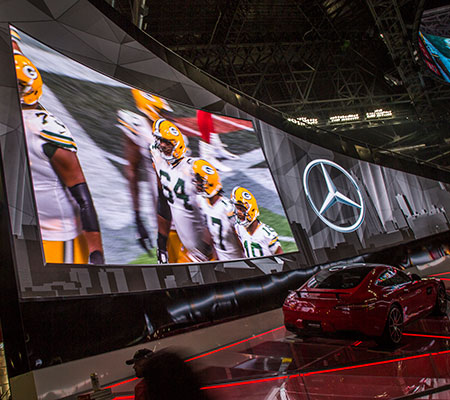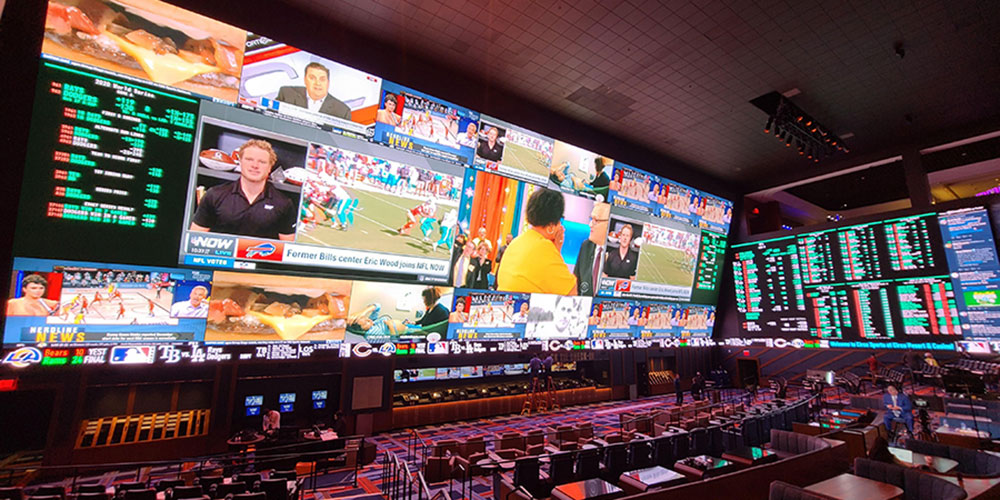Suspended high above huge crowds of eager onlookers, the enormous digital scoreboard is an essential part of the arena experience, so manufacturers must deliver on both safety and functionality. From production to assembly, increasing complexity needs to be addressed— and it all begins with efficient design. Learn how a leading manufacturer of digital signs and scoreboards leveraged CAD and PLM software to streamline the design process and lay the foundation for continuous improvement.
Daktronics delivers innovative onscreen entertainment
If you’re a sports fan, world traveler, or everyday commuter, you’ve probably seen the work of Daktronics, an industry leader in digital signage. Founded in 1968 and headquartered in Brookings, South Dakota, they are experts at designing and manufacturing large-format LED video displays, message displays, scoreboards, digital billboards, audio systems, and control systems in sport, business, and transportation applications.
From Times Square to your local high school football field, Daktronics has made its mark by subscribing to a simple approach: say yes as often as possible and leverage every opportunity, big or small, to think outside the box and deliver innovative products.
Highly customized orders can be challenging in the design and manufacturing stages
As a “yes-company,” Daktronics’ customer-centric approach helped them grow their audience and adapt as needed. But as orders increased and demand for customized, non-traditional applications became more prevalent, the team realized they were quickly outgrowing their 2D, drawing-focused tools.
At the time, they were using 2D AutoCAD to create every part, assembly, and installation drawing. All of the corresponding data resided within those drawings, which then became the unofficial documents of record. But this created real challenges for sharing data between teams, including the need to rely on outdated methods that simply slowed down the design, production, and installation processes. For example, the drawings were accessible only as hard copies, all of which were stored in a single room within the office. Anyone who wanted to reference one of the drawings had to physically go to that room and check it out, then check it back in.
When it came to manufacturing and assembly, some of the larger projects had to be test-fit on the factory floor, but then broken down, delivered, and reassembled on site, often from the parking lot of the customer facility.
These design and manufacturing processes served them well for some time but were not efficient enough to keep up with the growth rate they were experiencing. Simply “speeding up” design and manufacturing only introduced the opportunity for errors and diminished quality, thus with so many custom orders from a diverse base, the team needed a more strategic approach to design and production to meet unique customer needs at scale.

Daktronics turns to PTC for improved CAD and data management solutions
Having researched PTC technology, the Daktronics team determined that Creo Parametric could help evolve their design and assembly process for large, complex orders. Creo is PTC’s 3D modeling software that allows the user to create, analyze, view, and share designs downstream using computer-aided design (CAD) modeling capabilities.
The addition of Creo immediately opened a new realm of possibilities for improving product development and quality. One of those improvements addressed the frequent challenge of designing around complex parameters such as pixel pitch—the distance between pixels on a screen that ultimately impacts the viewing resolution and the distance from which the audience can still see clearly. As the team got into projects requiring tighter pixel pitches, the designs had to evolve to account for factors like sheet metal thickness tolerances and assembly techniques, which can impact overall timeline for getting the product to the customer.
Working in Creo to improve designs, they reconfigured basic “building block” design platforms that could be arranged in different configurations and in a manner flexible enough to accommodate varying design parameters like pixel pitch, curvature, and custom shapes. As a result, it became easier to make adjustments during on-site installations, avoiding the need to disassemble the entire display after realizing a mistake.
Even as Creo began to produce clear, consistent improvements, the need for a strong product data management (PDM) system was still evident. They tried different solutions for managing the new Creo files, including multiple homegrown PDM systems designed to phase out the hard copy document room, as well as PTC’s Intralink—a program for modifying design objects and performing basic data management operations. But in their multi-CAD environment, they needed a single PDM solution flexible enough to manage multiple CAD tools and consolidate all documents from their various homegrown systems.
After exploring the options, Daktronics inevitably chose PTC’s Windchill to improve their file and drawing management. The software, known for its core PDM and advanced product lifecycle management (PLM) capabilities, was the first step toward improved design processes that would help evolve Daktronics’ project fulfillment.

Daktronics explores streamlined workflow and improved field assembly solutions
With Creo and Windchill yielding positive changes in design and data management, the Daktronics team began to consider how they could focus additional efforts on meeting customer needs. They assembled a working group of various stakeholders from across the enterprise and met over the course of six to nine months.
After close examination of current needs and capabilities, they ultimately made the business case for implementing PLM capabilities within Windchill. This implementation would help them better manage the change processes and workflows that drive product development, leading to faster time to market and fewer errors in their enterprise resource planning (ERP) system. It would also help bridge the gap between engineering and other product teams, allowing for a smoother transfer of information.
With this decision, the collective group of design, engineering, manufacturing, and service teams built a roadmap for implementing new capabilities, planning a multiple-phase rollout according to business needs.
The first phase was to implement WT Parts, a software feature that allowed them to automate engineering bill of materials (eBOMs) into the ERP system. As WT Parts is the central hub of all information related to a particular part, it’s crucial that all relevant CAD files, drawings, engineering change history, and primary BOM structure get linked to the WT Part—allowing it to become the single source of truth throughout the entire process.
“It took convincing to be
done, from the day-to-day
engineer to upper
management, we all had
to realize that engineers
are truth tellers, and
everything else is derived
from that.”
— Randy Soukup, Engineering Systems Analyst, Daktronics
“The CAD model is the real one,” says Randy Soukup, Engineering Systems Analyst, of their realization about source of truth and subsequent culture change. “It took convincing to be done, from the day-to-day engineer to upper management, we all had to realize that engineers are truth tellers, and everything else is derived from that,” he continues. “We had to give that source of truth a new home and a new system so we could reap the benefits—and we’ve been starting to see those benefits for a while.”
Implementing WT Parts also meant they could leverage automated workflows and streamline processes to cut down on manual errors of the BOM entry and everywhere else from CAD systems down to the actual factory floors.
“We’ve realized how many times we had to type in a BOM and how streamlined it is now,” says Andy Hermanson, CAD/PLM System Administrator. “Now it’s built right after the CAD structure, and we just click a button and check it in and it’s pushed into the ERP, making for a much simpler process.”
With the first phase successfully implemented, Daktronics began focusing on subsequent phases such as change notice, followed by local documentation, supplier management, non-conformance, and deviations—all of which contribute to their business goals and focus on meeting customer needs.
PTC technology reduces design time and improves product quality
With their CAD and PLM roadmap established, one of the biggest improvements Daktronics has seen is the speed with which they can perform tasks and move from design to manufacturing. The automation of data entry eliminates duplicate entry and basic miscommunication, erasing the need to use valuable time correcting errors. Better tracking and version control means quicker access to drawings, parts, and files for teams across the organization, so they can quickly and accurately form workplans.
And in the case of simple, rectangular displays, design time has been dramatically reduced. “When I first started working in design groups, a traditional rectangle design could take a week, and a highly customized order could take two weeks or more to design,” says Soukup. Now, thanks to ease of use, an engineering student can do this, allowing more senior-level, specialized staff to focus on custom projects. “We’ve seen high-quality throughput expand exponentially with PTC tools and automation,” he adds.
All of these factors decrease time spent correcting errors and increase time spent on producing deliverables, which ultimately increases the bottom line and helps build their customer base. Not only are they gaining new customers, they’re improving service for current customers through better visualization capabilities that help buyers understand with confidence exactly what the product will look like in their venue. And once the product is delivered to the customer site, Daktronics can assemble it faster and with fewer errors.

Notably, it wasn’t just a change in technology that spurred all of the improvements. A shift in culture helped them collectively accept a new way of thinking and undo long-held behaviors. Soukup believes that moving forward, it will be a combination of the two that helps them move the needle toward even more advanced capabilities. “Time is always a huge challenge in design,” he says. “So we’re looking at these emerging technologies, to test-drive them, looking for ways to expedite our design process in the future to reach the result we’re looking for, but just in a different way—it’s definitely a paradigm shift, and getting people on board with a new way of thinking will be key.”
A commitment to continuous improvement points to a bright future
With new potential on the horizon, Daktronics is now working on a plan to digitally connect and monitor a portion of their paint machines used in the manufacturing process. Monitoring these machines used to be a tedious, manual process— but now they’re using Kepware to pull live data from PLCs into ThingWorx dashboards for real-time monitoring of paint sprayer pressure and oven temperature. This enhanced visualization gives Daktronics the insight to make timely adjustments to ensure production efficiency and quality.
They are also exploring ways to evolve their design processes with model-based definition and model-based enterprise, and push the limits of what’s possible by incorporating emerging technologies such as additive, generative, and real-time simulation.
With growing interest in augmented reality (AR), Daktronics is also exploring PTC’s Vuforia technology to add an extra “wow” factor to their already impressive customer experience. Having recently won a contract in which AR was used to help a potential client envision a digital overhead display in their arena, they’re now interested in incorporating it into their CAD software to help students and new employees learn about the design process. They’re even considering AR to help conduct design reviews through enriched, interactive experiences that provide 3D-views and a more hands-on approach.
“When a new contract comes in, now we have a better idea of what
processes will be and what hand-offs will be, so different groups
can talk through the set up. It’s been a homegrown but highly
successful evolution.”
— Andy Hermanson, CAD/PLM System Administrator, Daktronics
Hermanson explains that all of their established efforts—and even the future ones—to incorporate these advanced technologies can only serve to help them communicate more efficiently, not only with customers, but also among themselves. “As we implement more lean processes, we can better identify more areas where communication can be improved,” he says. “When a new contract comes in, now we have a better idea of what processes will be and what hand-offs will be, so different groups can talk through the set up. It’s been a homegrown but highly successful evolution.”

Looking back at their journey, Soukup believes the growing pains have been well worth it. “We’ve come a long way,” he says. “It used to be a couple guys storing stuff on folders on network drives. It’s way better now, and the toolset from PTC has helped us get here.”
PTC is eager to follow and support Daktronics’ continued journey, and knows if there’s one thing that’s clear, it’s this: When it comes to providing the ultimate digital viewing experience, Daktronics is an industry leader through and through—and thanks to their commitment to innovation and customer satisfaction, there’s no airport, office, or arena that they can’t liven up to the delight of viewing audiences around the globe.